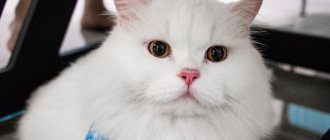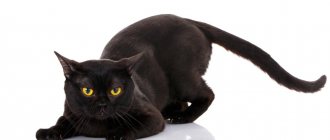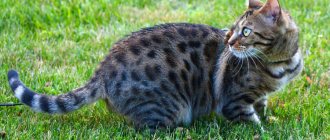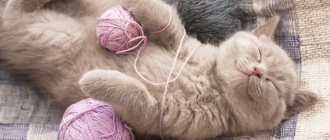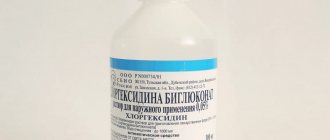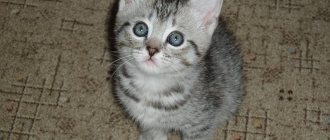Alopecia in cats is baldness, that is, hair loss. There can be many reasons for this condition in a pet - from skin infections and diseases of internal organs to stress or depression.
As a rule, animal owners who are faced with a similar problem first purchase vitamins intended for hair growth. Secondly, they purchase all existing medications for various parasites and skin diseases. And only after the pet’s condition does not improve, the cat is taken to the veterinarian.
What can cause hair loss?
Most often, alopecia in cats is caused by various skin infections and internal diseases. Among skin infectious pathologies, the most common causes of hair loss are:
- bacterial folliculitis;
- ringworm;
- demodicosis
Of the internal diseases that cause baldness, veterinarians most often diagnose the following:
- hyperadrenocorticism, or Itsenko-Cushing pathology;
- allergic reactions;
- disturbances in immune and hormonal processes;
- special conditions of the body;
- arthritis.
Special conditions of the body should be understood as pregnancy, old age, the recovery period after long-term treatment or feeding kittens.
Often developed alopecia in cats has more banal causes. The animal's fur may fall out due to the presence of fleas. A cat, just like a dog, scratches the bite sites and tries to catch parasites with its teeth. As a result of such actions, the animal literally tears out the fur with its claws and gnaws it out with its teeth.
If the pet does not have any internal pathogenic processes, allergic reactions, traces of parasite activity or infectious skin diseases, but the hair falls out, then the cause of alopecia lies in the psychological state of the animal.
Possible causes of itching
Often, a domestic cat often washes and scratches its neck behind the ears, its muzzle, tears the skin on its head and scratches itself so that its hair falls out or sores appear until it bleeds and scabs and scabs, and to find out why this happens and how to treat it, first The first thing you need to do is check whether he has fleas or not. If blood-sucking insects or their eggs are detected, you will need to immediately treat the animal’s fur with special preparations.
If no fleas were found during examination of the animal, then the cause of the itching may be as follows :
- skin diseases;
- hormonal disbalance;
- allergic reaction;
- endocrine gland disorder;
- lichen;
- the presence of parasitic worms (helminths).
To eliminate itching and protect a cat living at home from scratching its neck, back and other places, it is necessary to identify the source of its occurrence and carry out effective treatment. Next, the possible causes of the disease are discussed and what to do if the cat often licks itself until it hurts, what to give if it is constantly itching.
What is psychogenic alopecia?
Psychogenic alopecia in cats is similar to nervous hair loss in humans. That is, the hair begins to fall out due to experiences, stress, both long-term and short-term, but strong.
For example, a person often experiences hair loss after experiencing the death of loved ones, watching car accidents or fires, as a result of a parachute jump or visiting “free fall” attractions. This is a state of short-term stress, that is, a bright and strong emotion, fear, compassion or some other feeling. A characteristic feature of this condition is a very strong shake-up of the nervous system, followed by a kind of rollback. That is, after a while, consequences of the experience arise, among which baldness is often found.
A cat may feel the same way. If your pet is very frightened, upset or impressed by something, then some time after this event hair loss may begin.
Long-term stress is a condition in which an animal experiences discomfort and negative emotions for many days, and sometimes even years. Unfortunately, the most common source of long-term stress in animals is their owners. For example, a cat may begin to lose its fur because its owners are constantly dissatisfied with it, drive it off the couch or don’t let it go anywhere, scold it, or don’t pay attention to it.
Many people, in principle, do not think about what kind of attitude they show to their own pet. Not all animals and people are psychologically compatible. For example, an independent cat that does not tolerate familiarity will not care if its owner ignores it, as long as food appears in the bowl on time. But for a sociable, affectionate animal, bored by a whole day of loneliness within the walls of an apartment, the indifference of a person returning from work can cause deep psychological trauma.
Of course, in addition to human behavior and attitude, other factors may be the source of the development of such a condition as alopecia nervosa in cats. For example, vibration from an audio speaker or the presence of an aviary with birds in the apartment. Sources of long-term stress can lurk at every turn. They are always individual, each animal reacts in its own way to what surrounds it.
Prevention of itching: does it exist at all, and what can be done?
Itching is caused by various factors, so following a number of prevention rules will help protect your cat from scratching:
- Poison worms in a timely manner. This will also help protect children who constantly play with animals. You should not give your cat raw foods: fish, meat.
- After each walk, inspect the animal for abrasions. Treat detected wounds with iodine or other disinfectants.
- To avoid infection with parasites, the cat should not be allowed to come into contact with other animals.
- Disinfect the cat litter box regularly.
- The transition to a new food should be carried out gradually.
- Do not punish your cat for minor offenses: this will prevent stress.
How does psychogenic alopecia in a pet differ from human alopecia?
Psychogenic alopecia in cats, the treatment of this pathology and its manifestations, of course, differ from nervous alopecia in humans. In addition to the various medications and external care products used in therapy, there is a difference between cat and human hair loss in the reasons for the development of alopecia.
It lies in the fact that a cat is capable of acquiring a conditioned reflex to scratching, licking and, accordingly, depriving itself of hair. This usually occurs after a skin infection or internal disease has been experienced and cured. Often, a cat that has been deprived of kittens begins to lick itself, and does it with such frenzy that it tears out the fur. In humans, such a reflex is not formed.
There are also frequent cases when reflex psychogenic alopecia in cats becomes a consequence of itself. That is, in cases where a cat has experienced hair loss caused by stress, it can also continue to reflexively itch and lick itself, preventing the fur from growing back.
Treatment at home
Treatment at home includes taking medications and following a special diet.
Medicines for helminths
The drug is selected depending on the type of disease:
- Scabies from flea bites is treated with special drops and sprays. Anti-flea shampoos are used during bathing. Then a flea collar is put on the animal.
- Itching caused by fungal infections is eliminated with drugs from the griseofulvin group. The antifungal agent is applied externally. You can also get vaccinated.
- To get rid of ticks, acaricidal substances are used in the form of drops, sprays and shampoos. Drops against ear mites are instilled into the ears.
- To eliminate allergic reactions, it is necessary to remove the allergen from the diet and care products. For further treatment, antihistamines are used.
- Deworming medications help get rid of worms. During the examination, the doctor identifies what type of worms have affected the intestines and prescribes appropriate treatment.
- Dermatosis, otitis media and other infectious diseases are treated with antibiotics and anti-inflammatory drugs. To strengthen the immune system, the animal is prescribed vitamins A and B and immunostimulating drugs.
- Allergic dermatitis and ear scabies are treated with Stronghold. This drug is released in the form of drops that are applied to the animal’s neck. It also helps with flea bites.
What are the main causes of psychogenic feline alopecia?
As with any disease, in the case of a diagnosis of alopecia in cats, treatment begins with identifying the causes of this condition and eliminating them.
The most common causes of hair loss caused by psychogenic factors are:
- long-term and short-term stress;
- experienced skin infections and diseases;
- pregnancy and childbirth.
Eliminating the cause of alopecia is an important part of therapy. If the factor that causes hair loss in a cat remains in its life, then no treatment will be able to prevent hair loss.
Treating a cat for parasites
Treatment must be prescribed by a doctor. Most often, complex spot-on preparations (pipettes with medicine on the skin) are prescribed in an intensive mode - every 10-14 days. The most commonly used are “Stronghold” and “Inspector”. In case of skin infection, the doctor will prescribe local treatments with antiseptic solutions and even antibiotics. Recently, information has appeared about the effectiveness of the Bravecto tablet used in dogs in cats. Studies have already been conducted and safe doses for cats have been determined. However, there is no information in the instructions yet, but it will probably appear very soon.
How is this alopecia located?
Symmetrical alopecia in cats usually accompanies mental trauma, stress or other psychogenic factors that cause hair loss.
The most common manifestation of psychogenic hair loss is hair loss on the ears. In some animals, they can become naked literally overnight, and when the source of disturbance is eliminated, they can just as quickly become overgrown.
Psychogenic alopecia can develop on any part of the body; slight asymmetry in its location is also possible in cases where the disease has a reflex type of development.
Infestation by exogenous insects
Both fleas and other bloodsuckers can parasitize a cat’s body . The presence of these insects leads to the occurrence of various diseases. The most dangerous of them include:
- flea dermatitis;
- mite damage: sarcoptic mange, notoedrosis.
When a flea bites, a wound with their saliva remains on the animal's body, causing severe itching. The cat begins to vigorously scratch the affected area, which leads to the infection getting inside. The inflammatory process in combed areas is manifested by redness and hair loss.
When infected with ticks, the clinical picture in cats is as follows::
- severe itching on dry areas of the skin;
- hair loss;
- formation of ulcers on exposed areas.
Notoedrosis in cats is manifested by the presence of Notoedres cat mites and is accompanied by the following symptoms:
- itching and severe scratching;
- rash in the form of blisters;
- the appearance of crusts on itchy areas;
- hair loss;
- loss of skin elasticity, appearance of cracks infected with bacteria and fungi.
Sarcoptic mange occurs in cats due to their infestation with mites of the species Sarcoptes canis . These tiny bloodsuckers are 0.2-0.4 mm long and have a long proboscis. Thanks to this, they easily gnaw holes in the skin and make a large number of moves in it. Once on the animal's body, the parasites begin to actively lay larvae. In this regard, already 1.5 months after their appearance, their numerous offspring are present on the cat’s body.
The main symptom of this disease is severe itching, which gets worse in the evening. First of all, the tick infects areas on the animal’s head, neck, and near the ears, where blisters and redness immediately appear. After a while, these places become covered with dried crusts. The animal becomes restless, constantly itches and meows. Constantly scratching itchy areas, the cat cannot sleep, loses its appetite and experiences weight loss.
Therapy involves not only getting rid of bloodsuckers, but also healing damaged skin areas, as well as restoring the pet’s immune system.
Which cats are prone to psychogenic alopecia?
Any cat can go bald due to stress or due to other reasons related to nervous activity.
But some breeds are much more prone to psychogenic hair loss. These cats include:
- Siamese;
- Burmese;
- Anatolian;
- Abyssinian;
- lop-eared;
- Bengali;
- Bombay;
- American Shorthair;
- British shorthair and blue.
Endocrine alopecia in cats is also more common among representatives of these breeds than in other animals.
The cat itches until it hurts and the hair falls out: How to treat it at home?
Every owner should understand that many drugs that can be used by humans and other animals cannot be used on cats.
For example, skin lesions are often treated with Yam BK ointment. This is strictly forbidden, since the tar contained in this drug is toxic to cats.
Like this article? Read other materials about cats on our website: How to give medicine to a cat? Tips for ensuring comfort for a cat - https://strazhchistoty.ru/cleanup/cleancats/kak-dat-lekarstvo-koshke.html How to learn to understand your cat (Practical tips) - https://strazhchistoty.ru/cleanup/cleancats/kak -ponimat-koshku.html
How can you help yourself without causing harm?
Try to limit access to the body area if the cat injures itself. A protective collar or blanket can help with this.
Trim your cat's claws or apply safe anti-scratch pads.
Itching can be controlled using a suspension or spray with the same name Stop Itching . It is important to understand that you will only remove the symptom, and after a course of the drug the problem may return.
The crusts can be soaked and removed using saline or Chlorhexedine.
Also, if there has been no treatment for fleas and ticks for a long time (the apple tree is a month old), it is worth doing it. Suitable drugs: Stronghold, Lawyer, Helmintal, Inspector, Bravecto.
And, of course, we recommend taking your pet to see a doctor as soon as possible.
Are there cats resistant to alopecia?
There are no animals that are absolutely resistant to nervous shock and stress. However, there are breeds for which hair loss due to psychogenic factors is rare.
These cats include:
- classic Persian and exotic;
- Norwegian forest;
- longhaired American bobtails;
- European Shorthairs;
- meikuns.
Of course, these animals are also capable of getting sick due to nervousness, but representatives of such breeds are less prone to strong emotions than others.
Characteristics of hair in cats
If you compare the hair structure of a person and a pet, you will notice many differences. Unlike people, most pets are not prone to baldness - their dense hair remains almost unchanged even in old age, despite periodic molting. If your pet suddenly loses its fur, it is important to find out why it happened as soon as possible.
The following areas are affected by baldness:
- stomach;
- hips;
- hind legs;
- back;
- tail part.
Sometimes this phenomenon serves as an initial sign of serious diseases that are difficult to treat. The reasons that a cat is going bald can be very different: from absolutely harmless to more serious ones that require immediate examination of the animal by specialists.
Does psychogenic alopecia have symptoms?
The only symptom of psychogenic alopecia is the loss of hair by a cat without any objective reason for this. That is, if fleas, ticks, internal diseases, endocrine and hormonal disorders are detected, there can be no talk about the psychogenic nature of hair loss.
When alopecia develops for nervous reasons, the hair falls out unevenly. On some days the amount of fur lost may be greater than on others. If a cat demonstrates behavior that is unusual for it before, then it is urgent to fully examine the animal, since with psychogenic alopecia the pet’s habits do not change.
Typical symptoms
Signs of developing alopecia are easy to detect even without veterinary education. The first symptom is thinning hair on the sides of the body, behind the ears, and in the tail area. Progressive pathology provokes the appearance of other characteristic signs:
- hair loss in large clumps;
- exposing areas of skin that acquire a pink or reddish tint;
- formation of unsightly crusts in areas affected by alopecia.
If your cat is going bald due to a serious medical condition, sores, scabs, or whitish bumps may form in the problem areas. The skin in the bald area sometimes becomes hot and loses its natural elasticity.
How is this type of alopecia treated?
The main thing in the treatment of all psychogenic disorders of animals, including alopecia, is the elimination of the factor that negatively affects the pet’s condition. This is precisely the main difficulty of therapy.
No special medications are required to treat these disorders. As a rule, medications are limited to sedatives, vitamins and immunomodulators. In addition, special care is recommended using external agents that stimulate hair growth.
What measures are needed to prevent the problem?
The problem has been identified, the cat is scratching its neck and hair is coming out. And the bald patches all over the baby’s body say that you can’t cope with the problem on your own. What to do? The best thing to do is go to a veterinary clinic. An accurate diagnosis is needed. Tests and monitoring of the cat’s general condition will help you find out exactly what is causing hair loss from the kitten’s neck.
You may have to change the food or cleanse your pets of parasites. Only a doctor can decide whether vitamins or medications are needed to treat your cat.
Diagnosis of the disease
The main task of an owner who notices that his cat is balding in the ears, back, abdomen and other parts of the body is to contact a veterinarian for a subsequent examination and diagnosis of the root cause that caused this problem.
To diagnose alopecia, the following measures may be necessary:
- analysis of medical history;
- visual examination of the skin, ear and mucous membranes of the cat;
- microbiological examination of wool bulbs;
- blood tests;
- analysis of epidermal scraping;
- hormone analysis;
- Ultrasound;
- X-ray examination.
All these methods together will help identify the presence of a disease that negatively affects the cat’s fur.
Why does a cat go bald: reasons
In fact, hair loss in animals, like in humans, is constant, but the alarm should be sounded when hair loss takes on catastrophic proportions and is complemented by other signs. This may include weight loss, lack of appetite, increased nervousness or apathy, diarrhea, vomiting, high body temperature and more. In this case we are talking about pathology.
Shedding
This is the most harmless phenomenon that causes temporary thinning of the cat's fur. Mammals (and cats are no exception) are characterized by 3 types of molting:
- age;
- seasonal;
- compensatory.
During age-related molting, the primary soft fur changes into adult, spinous and coarse hair. Compensatory molting is the body’s response to external chemical damage to the skin.
Seasonal shedding occurs in spring/autumn and is designed to adapt the cat to weather changes. Short and thin summer fur has increased thermal conductivity, while winter fur, thick and long, protects the animal from hypothermia.
This shedding usually lasts from 2 weeks to 2 months, while the cat demonstrates excellent health:
- the epidermis does not change color;
- body temperature is normal;
- no bald spots;
- the eyes are shiny and the nose is moist;
- the mood is even.
In city houses, molting sometimes drags on, and the culprit is considered to be excessively humid or, conversely, dry air. Excessive dryness is dealt with using household humidifiers. If you want your cat to change its fur faster, include vitamins in its natural food and brush its fur more often.
Heredity
Excessive loss of cat hair can also be caused by bad genetics, which are responsible for such hereditary ailments as adenitis, hypotrichosis, seborrhea, juvenile demodicosis and others.
The causes of baldness in cats can be congenital or acquired. Congenital ones include those that affect the body of a pregnant cat:
- lack of vitamins and minerals in the animal’s diet;
- stress;
- diseases of various nature;
- unbalanced diet;
- starvation and, as a result, exhaustion.
Exposure to these same causes even before pregnancy can serve as a prerequisite for the occurrence of alopecia in the future generation, as a result of which the fetus experiences disruption of the endocrine glands and disruption of the formation of hair follicles.
This should also include hereditary anomalies that arise, among other things, from inbreeding. However, it is important to clarify: if hereditary anomalies are accompanied only by the absence of hair (partially or completely), and not changes in the anatomical location of organs or disruption of their functioning, then we can talk about individual, and in some cases breed, affiliation. It is these anomalies that underlie the creation of cat breeds: Sphynx, Bambino, Elf, Ukrainian Levkoy, Cojona.
Acquired baldness in cats can be a symptom of a disease of the skin itself:
- dermatitis (inflammatory skin diseases);
- seborrhea (increased secretion of the sebaceous glands);
- parasitic diseases (scabies) or fungal infections (ringworm, favus, trichophytosis).
This also includes alopecia, as a result of aging hair follicles, or from constant injury to certain areas of the hairline. Another large group of factors that cause alopecia in cats are disturbances in the functioning of the body itself:
- stress: the cat itself intensively licks and plucks areas of the skin;
- allergies to food, medications, flea bites, odors,
- low-quality zoocosmetics, etc.;
- hormonal status disorders: diabetes mellitus, insufficient or excessive levels of thyroid hormones, adrenal glands, etc.;
- intoxication (acute or long-term infectious disease);
- inflammatory processes;
- blood diseases;
- condition after difficult childbirth;
- lack of vitamins, especially groups A, C, B;
- malignant tumors of internal organs.
In some cases, the cause of hair loss in a cat remains unknown, then we are talking about the unknown nature of baldness.
Baldness (alopecia) leads to the appearance of bare patches of skin on your pet's body.
If there is too much hair, bald spots appear, the animal behaves restlessly
The main reasons for the development of pathology:
- allergic reaction;
- damage by fleas, lice;
- the presence of a scabies parasite;
- otodectosis (ear mites);
- fungal or lichen infections (dermatomycosis, dermatophytosis);
- pyoderma;
- purulent formations on the skin;
- oily seborrhea;
- deficiency or excess of thyroid hormones;
- increased work of the adrenal glands;
- diabetes;
- genetic predisposition;
- stress;
- lack of vitamins;
- chronic diseases of internal organs.
Seasonal molt
Seasonal shedding
Seasonal shedding occurs in cats twice a year - in early spring and late autumn. At the same time, the fur falls out evenly, without bald patches, the animal looks and feels as usual. For apartment residents, this process can take several months, which is also considered normal.
You can make the process easier if you brush your cat daily and help her get rid of excess hair.
Endocrine disorders
Endocrine disorders are characterized by localized hair loss on the back, near the tail. Bald spots appear, in these places the skin may have a dull appearance and peel. As a rule, the signs are characteristic of animals that are overweight, have helminths, or have an improper, unbalanced diet.
If endocrine disorders are detected, treatment will require taking special medications and adjusting the diet. It is also necessary to carry out deworming with high-quality medications. It is necessary to stop feeding from the table and balance the diet separately.
Lichen
With lichen, the hair falls out in clumps, round bald spots form, and the skin peels off in place of the lost hair. Mycosis is dangerous not only for animals, but also for people, so it is very important to consult a specialist in a timely manner
If you find even one small round bald spot, it is better to immediately consult a doctor. Firstly, adults and children can become infected with lichen, and secondly, the lesion threatens significant hair loss if inadequate or self-treated.
The fact is that mycoses are caused by several types of fungi; this can only be determined by the results of laboratory tests. Accordingly, after them, adequate treatment can be prescribed.
Skin mite
Skin mite
When infected with a skin mite, hair may fall out separately on the face, ears or paws, sometimes in these places simultaneously. Infection with parasites also requires contacting a veterinarian and prompt treatment.
To treat it, toxic drugs are used, the dosage of which is determined by the doctor. Self-medication may have adverse effects on the animal's body.
Allergic dermatitis
In some cases, hair loss can occur when the animal reacts to antibiotics, metals such as nickel, rubber, wool, plastic, household chemicals and certain foods. In this case, itching, redness of the skin, blisters, and chronic hair loss are observed.
Hair loss due to allergic dermatitis is quite simple to eliminate by protecting the cat from contact with the sources that caused it. Over time, the unfavorable process should stop. It is also necessary to deal with foods and very carefully introduce new ones into the diet.
Hair loss is also typical for animals that have undergone serious illnesses and operations. Supplement food with complexes of vitamins and microelements, provide complete and high-quality nutrition.
In case of hair loss, only a specialist can determine the causes and prescribe treatment. After all, if it does not occur during the molting period, this is a signal that not everything is in order in the cat’s body.
A.N. Gerke, Ph.D., veterinary dermatologist, member of the European Society of Veterinary Dermatologists (ESVD) / A. Gerke, DVM, PhD
Hair loss (partial or total), or alopecia, is the second most common reason (after itching) for cat owners to visit a veterinary dermatologist.
There are many causes of alopecia in cats. Most of these cats suffer from itching due to allergies, and therefore lick themselves vigorously. The most common cause of hair loss is self-induced alopecia.
Unlike dogs, endocrine causes rarely lead to alopecia; in rare cases, extensive atrophic alopecia can occur with iatrogenic Cushing's syndrome and hyperthyroidism in cats. Severe stressful situations can also cause excessive licking, but the diagnosis of psychogenic alopecia should only be considered as a diagnosis of exclusion, after eliminating other, more likely causes of alopecia.
Just like endocrinopathies, psychogenic alopecia in cats is, in most cases, a consequence of overdiagnosis. This pathology is noted in purebred cats with “increased nervousness”, in which environmental changes, such as the appearance of new pets, children, change of owner, moving, pain, provoke the appearance of self-induced alopecia.
We invite you to read: Anatolian cat: description, nature of the breed, features and interesting facts
Dermatophytoses (“lichen”) can also cause alopecia, and the disease does not always begin with characteristic round lesions covered with gray crusts. Alopecia in cats often occurs due to flea bites. None of the clinical signs exclude diseases that have similar symptoms, so diagnosis must be carried out step by step.
To make a correct diagnosis, it is necessary, first of all, to carefully analyze the anamnestic data (the age at which alopecia first appeared, how quickly it progresses, on which parts of the body hair loss began, seasonality, whether sneezing, coughing, diarrhea were observed; feeding and reactions when changing food ;
